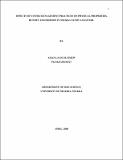UNNSpace Repository
Effects of Cover Management Practices on Physical Properties, Runoff And Erosion in Nsukka Sandy Loam Soil
JavaScript is disabled for your browser. Some features of this site may not work without it.
| dc.contributor.author | Amana, Sani Mathew
|
|
| dc.date.accessioned | 2016-02-26T09:50:08Z | |
| dc.date.available | 2016-02-26T09:50:08Z | |
| dc.date.issued | 2016-02-26 | |
| dc.identifier.uri | http://hdl.handle.net/123456789/1399 | |
| dc.description.abstract | A two –year (2004/2005) field investigation was carried out on the runoff plots at the University of Nigeria Nsukka farm, to monitor the effects of cover management practices on physical properties, runoff and soil loss in Nkpologu sandy loam soil. The management practices were barefallow (BF), cocoyam (CY) sorghum (SG), legume (CP) and grass (PM), under no-till practice. There was no change in soil texture due to treatments. The treatments generally increased soil organic matter content compared with the control. Bulk density was significantly increased in all treatments with highest value (1.65Mg/m3) in barefallow and lowest value (1.49 Mg/m3) in grass. There was no significant decrease in porosity and pore size distribution. Mean weight diameter (MWD) of aggregates and saturated hydraulic conductivity (Ksat) were significantly increased (p = 0.05). The least values for MWD (1.06mm) and for Ksat (25.80cm/hr) and highest for MWD (2.09mm) and for Ksat (49.20cm/hr) were obtained under barefallow and grass treatments respectively. The percentage aggregate size above 2.0mm was highest in grass and lowest in barefallow. Calculations showed significant positive correlation (r = 0.50 at P = 0.05) between organic matter and MWD. There was significant negative correlation (r = -0.60 at P = 0.05) between organic matter and bulk density and significant positive correlation (r = 0.80 at P = 0.05) between organic matter and saturated hydraulic conductivity. The pentades were generally wet during the study periods in the two seasons. Cumulative runoff was highest in barefallow and lowest in sorghum (87mm and 41mm respectively). The highest soil loss of 1.13kg/m2 and relatively low loss of 0.55kg/m2 were obtained in cocoyam and sorghum respectively in 2005. Runoff and soil loss were reduced by 100% under grass and legume. Cocoyam and sorghum reduced runoff by 20% and 53% respectively. Sorghum reduced soil loss by 35%, while there were no differences in the percentage reductions due to barefallow and cocoyam treatments. Runoff as percentage of rainfall was highest in barefallow and lowest in sorghum (60.6% and 19.9% respectively). Erosion rate was lowest in sorghum (0.2kg/m2/month) and highest (0.4kg/m2 month) in cocoyam. Under BF the rate was 0.3kg/m2/month. The mean yield of cocoyam was 1.35t/ha and that of sorghum was 0.88t/ha. | en_US |
| dc.language.iso | en | en_US |
| dc.subject | Cover Management Practices | en_US |
| dc.subject | Runoff | en_US |
| dc.subject | Erosion | en_US |
| dc.subject | Nsukka Sandy Loam Soil | en_US |
| dc.subject | Sandy Loam Soil | en_US |
| dc.title | Effects of Cover Management Practices on Physical Properties, Runoff And Erosion in Nsukka Sandy Loam Soil | en_US |
| dc.type | Thesis | en_US |
